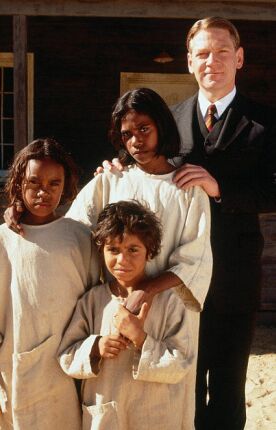Rabbit-Proof Fence
At the end of Rabbit-Proof Fence, directed by Phillip Noyce and based on a true story, the bad guy, Mr. A.O. Neville (Kenneth Branagh), who was styled the “Chief Protector of Aborigines in Western Australia” in 1931, says: “If only they” — meaning the Australian aborigines — “would understand what we are trying to do for them.” The line is meant to be drenched in irony. Mr Neville, called by an obvious rhyme, “Devil” by the aborigines themselves, has been presented to us with about as much sympathy or understanding as the caricature child-catcher in Chitty Chitty Bang Bang. And yet there is another, unintended irony in it, born of the fact that Mr Noyce has obviously made no effort himself to understand what Neville was trying to do.
Let me hasten to add that there can scarcely be two opinions, in our enlightened times, that his ordering three “half-caste” girls (among many others) to be taken from their aboriginal mothers and sent to a school 1500 miles away, where they would be trained as domestic servants, was wrong in several important ways, most notably because of his offensive and patronizing race consciousness. Neville is shown presenting a slide show (to whom, we are not told) in which he explains that the taint of blackness in the mixed-race children can be bred out of them in three generations if they are raised among, and presumably marry, white people.
This might actually have been considered an enlightened attitude for its time, when in much of the American South, for example, “a touch of the tar-brush” was regarded as eternally damning. But, silly or evil as both attitudes now seem to us to be, Neville’s at least was not entirely based on race. More importantly, he believed as nearly all white people did in 1931 that European, Anglophone and Christian culture was infinitely the superior of that of such indigenes as the Australian or African blacks, and that it really was doing them a favor in all kinds of ways to attempt to wean them from their lives as nomadic hunter-gatherers or subsistence farmers and introduce them to the advantages that they saw as belonging to their own lives.
It is obviously much easier now than it would have been at the time to see how grievously he was mistaken, and to make such a point of the fact as this film does is just shooting fish in the old cinematic barrel. Boo! Hiss! Take that, Neville, you skunk! Where’s your Nazi uniform? And, indeed, that infallible synecdoche of movie evil would not be out of place here. When the three little girls escape from their new boarding school, he tries to hunt them down, with the help of an aboriginal tracker called Moodoo (David Gulpilil) whose own daughter is at the school, and send them back as they walk for weeks to reach their home along the eponymous rabbit-proof fence that runs through the center of Western Australia. One of them is recaptured, two escape.
The film is blessed with spectacular photography by Christopher Doyle and remarkable performances by the three girls, especially Everlyn Sampi as Molly, who leads her sister Daisy (Tianna Sansbury) and cousin Gracie (Laura Monaghan) on their journey of over a thousand miles. The viewer is left to assume that the two escapees lived happily in the bush, killing an occasional iguana for food, for the rest of their lives, though this is not quite what happened in real life. But in the film’s final frames we see the two survivors, obviously proud of their epic feat of 70 years ago and so lending sanction to the film’s assertion that such a life, or indeed any life, was much better for them than one of assimilation, as proposed, into Australia’s dominant culture.
This, the view of many contemporary aborigines, may of course be true, though it is not self-evidently true. Still less is it possible to take it for granted that the compulsory training of the aboriginals in useful skills in the years before 1970 was tantamount to, as the Royal Commission to investigate what are now being called “the stolen generations” said in 1997, “genocide.” The more interesting story than that of the deluded child-catcher, Mr Neville, might be what this easy equivalence — a further stage on the way, for politically correct culture, towards being able to classify anyone who was an adult white male before 1970 as the equivalent of a Nazi — tells us about us.
Discover more from James Bowman
Subscribe to get the latest posts to your email.








